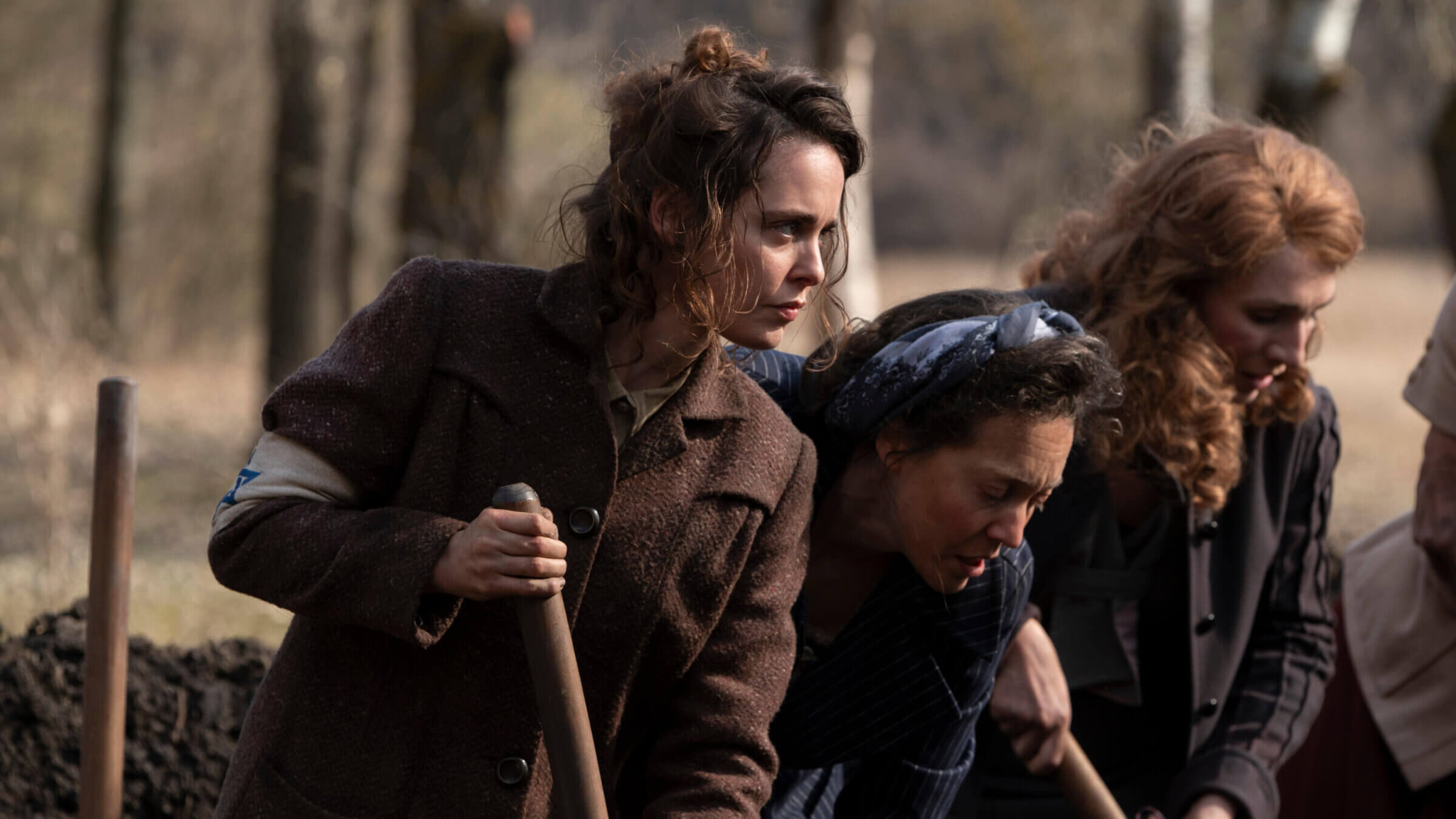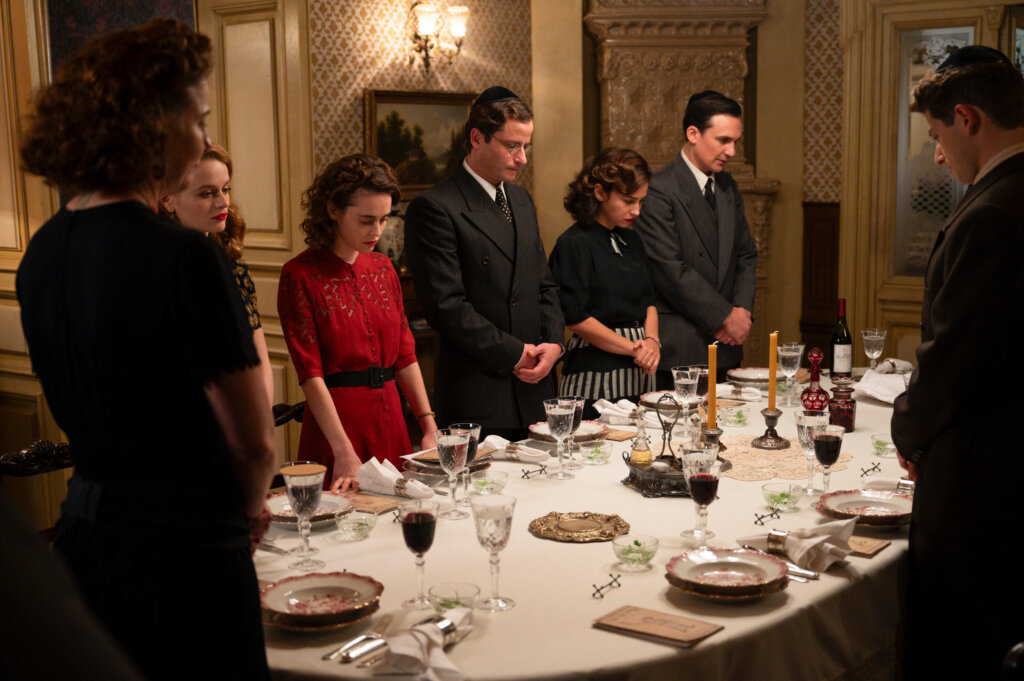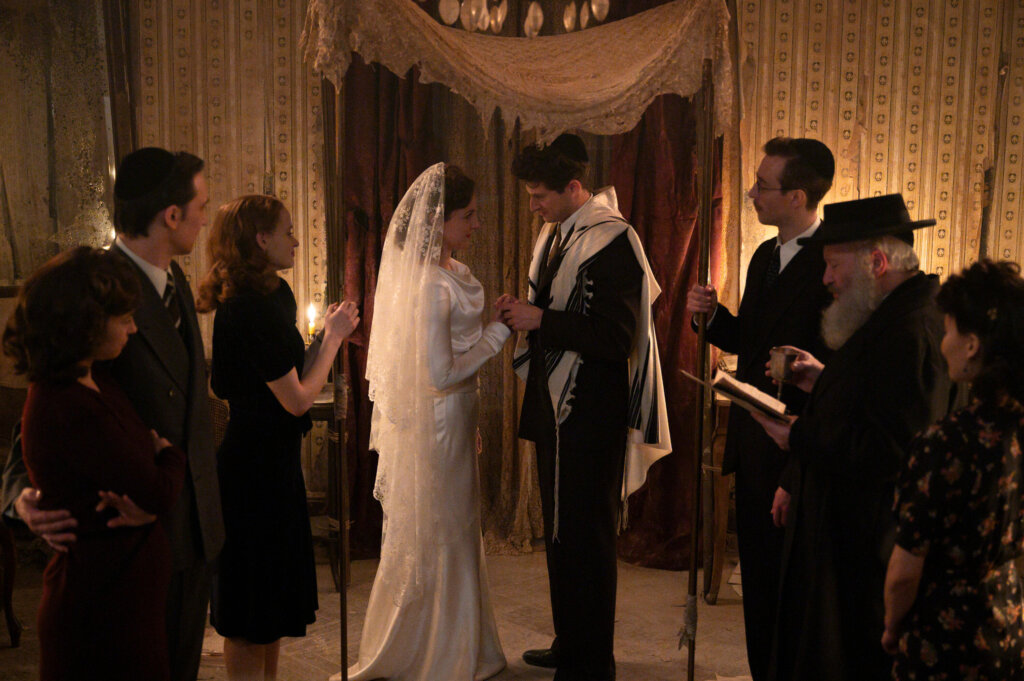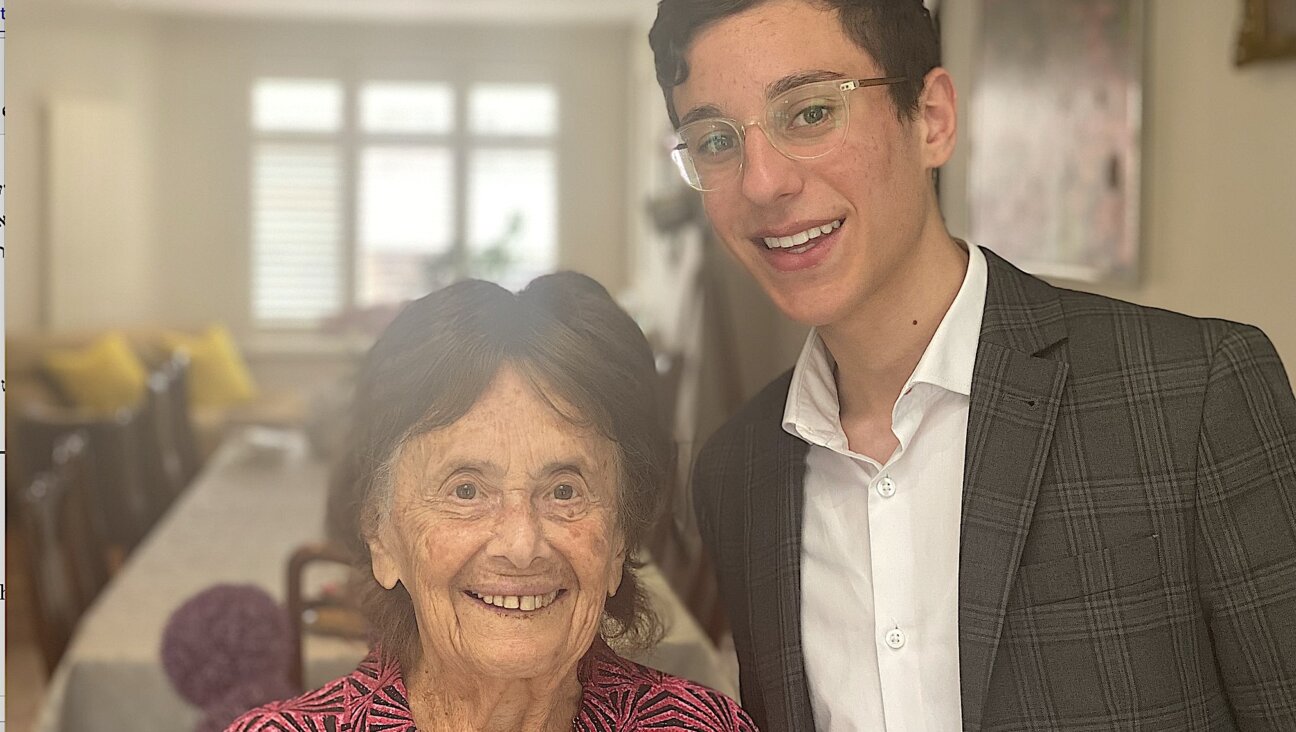What’s behind the boom in Holocaust TV?
In the past year, the era of mid TV has come to include the Holocaust. What’s going on?

Mila (Hadas Yaron) digs her own grave that she somehow escapes from. Courtesy of Hulu
As Jewish journalists, we get a lot of pitches about the Holocaust. A book about Mengele, a documentary about the Bielski partisans — maybe a movie about some forgotten savior of Jews. What we haven’t seen a lot of is scripted TV. After all, who is trying to unwind after a tough day at work with an evening of Auschwitz?
But something has changed. Last year, there was A Little Light, a show focusing on Miep Gies, the Dutch woman who hid Anne Frank. Even The New Look, a show ostensibly about the rise of a French fashion house, focuses largely on the Nazi occupation of Paris.
In the past few months, we got yet another set of Holocaust shows: We Were the Lucky Ones, based on the 2017 novel and starring Joey King and Logan Lerman, which follows the true story of the Kurc family in Poland as they successfully evaded the Nazis; and The Tattooist of Auschwitz, a TV adaptation of the bestselling but poorly fact-checked novel of the same name. The show switches between Lali Sokolov’s time as one of Auschwitz’s tattooists, and the early 2000s, when author Heather Morris is interviewing him.
What does it mean — for the entertainment industry, and for the broader project of remembrance — to have so much Holocaust TV? Are the shows any good, or are they at least accurate? We discussed the phenomenon, and the impact of the newest entries into the genre.

The era of Holocaust TV is upon us
PJ: My sense is that in any given year there is a lot of Holocaust content, but it’s not always so high profile. The last time we had so much on TV was probably around the time of that miniseries Holocaust in the late ‘70s when it was very zeitgeisty — those stories were then pretty novel for television. The only other time I really can think of where it was a “TV event” was in Band of Brothers, where they liberate a camp in the penultimate episode.
Do you think the world’s renewed interest in fascism as a viable ideology — and also the groundswell of highlighting identity in storytelling — is a factor now?
Mira: I think the generous theory is that a few years ago, when we were seeing a lot of comparisons between the pandemic and Jewish ghettos or vaccine cards and yellow stars, and politicians like Marjorie Taylor Greene were spouting antisemitic tropes, various producers decided to put some topical and educational Holocaust programming into the pipeline that’s just bearing fruit now.
But I worry that what’s really happening is a side effect of what New York Times television critic James Poniewozik termed our era of “mid TV.” Prestige TV had a good decade or so, but during the boom, studios began to go for quantity over quality. The side effect is that now everything has the big budget and high production value of prestige TV, without necessarily having groundbreaking storytelling or creativity — so much TV today is perfectly watchable, but nothing special.
So producers are looking for some element of added seriousness to prove that they’re making something worth watching, and set themselves apart from the crowd. And a topic like the Holocaust automatically conveys that weightiness. It’s sort of an awards-bait tactic.
Imagining the unimaginable
Mira: I think there was a period where Holocaust media was all really informative. I know when I was in middle and high school, movies like Schindler’s List really taught me new things about the Holocaust. And I think stories like We Were the Lucky Ones are well-researched enough to contain a lot of information that might be new to people — stories from outside the concentration camps, for example, that show the ingenuity families used to survive, and portray Jews as more than victims.
Unfortunately, I think the volume of shows fundamentally just makes the Holocaust become mid TV — we become inured to its horrors, just like we’ve gotten used to high-value production. I know I think to myself, “Oh, God, another Holocaust show, really?” We’ve made the unimaginable far too imagined.
PJ: Yeah, Adorno would plotz. But because there is such an emphasis on testimony, at least in one of these shows, Tattooist, there’s actually a danger in that it gets things wrong. Sokolov said that he maneuvered to get penicillin to save Gita’s life, and that’s an anachronism that made its way into the book and the show.
This is Lali’s remembrance of Auschwitz, but if he got that wrong, what else is he misremembering? When people are already denying the Holocaust it’s probably not the best idea to rely so heavily on an unreliable narrator.
Mira: Tattooist also spends a lot of time with the character of Heather Morris, the author who wrote Lali’s testimony into a bestselling novel focused on his love story with Gita. She pushes Lali to tell his story and is constantly saying that the world needs to hear it. But she’s also this total outsider: She’s not Jewish, she’s sort of grotesquely fascinated by the horrors he recounts and she’s nakedly ambitious — she wants to leave her job as a social worker at a hospital and become an author.
Heather becomes a sort of vehicle — though not one I think the show necessarily intended — for the way that the world relates to these Holocaust stories. People are hungry for them, and it’s easy to say that it’s noble to educate and tell people about the Holocaust, but the real drive to do so is often not quite so pure. The producers of shows like this are in it for the story; they want to find a clear narrative arc and an inspirational kernel of the light in the darkness, like Lali and Gita’s love story, that wraps into a neat package. But the reality of peoples’ experience in the Holocaust was never that clean.
PJ: The amazing thing about Lali’s story to me is that it’s not very interesting despite Heather Morris’ insistence it is. It fails as a love story — Gita is very underdeveloped. The fact that Lali was employed as a tattooist in the camp, the source of his torment and his vision of an SS officer ghost, is actually a relatively innocuous detail when we think about all the awful jobs the Nazis made Jews perform. (Especially since it wasn’t quite sophisticated enough to make a point about reducing people to numbers and how his part in that dehumanization affected him.)
He was working with the population that was selected to live — people who were sent directly to the gas chamber weren’t tattooed — and inmates had to do much worse things to survive. It does give us these sorta gauzy, lingering shots of people’s forearms though while the “somber music,” as the subtitles describe it, plays underneath.
Mira: Yes, the show makes a lot out of how physically painful the tattooing was, which strikes me as odd given that it was far from the most horrifying experience people went through in the camps.
Also, I’m sorry, but those sex scenes in Auschwitz were really uncomfy. People did have sex and fall in love in the camps, sure, but the swelling music, the camera zooming in on them kissing each other’s necks — it’s like we were suddenly transported to a steamy sex scene from an action movie or something.
Is Holocaust TV adding anything to our understanding?
Mira: What do you make of the way Jewishness is handled in these shows?
PJ: Tattooist is fundamentally disinterested in Nazi ideology. It does the thing where people yell “Jews” and spit at them, but doesn’t give us more than that. There are also some Hebrew prayers here and there, sometimes identified in the subtitles as “speaks native language.”
Overall, Jewishness feels largely incidental. Imre Kertesz regarded as kitsch anything that made Auschwitz seem like a matter just between Jews and Germans “a fatal incompatibility between two groups,” that took it away from a universal experience. In that way I guess Tattooist isn’t kitsch, but then, everything else about it is.
We Were the Lucky Ones, on the other hand, bookends everything with a Seder scene (albeit one that has a tune for Dayenu that developed decades later on a different continent). In that show, Jewishness and Jewish ritual are a lot more central, but there is also some ambivalence from the younger characters to their identity.

The kids survive by pretending to be gentiles; the brother who ends up joining the Polish Army asks to learn some Catholic prayers to enlist and sort of dismisses how posing as a Christian could be sacrilegious, saying he went through the motions of Jewish education to please his dad. But by the final scenes you sense that the experience of the ‘30s and ‘40s — and all of the younger generation now having small children — has made it so Jewishness will have a much deeper meaning to this family going forward, with the possible exception of the novelist, Georgia Hunter’s, grandparents. She only learned her grandfather was Jewish and a survivor after he died.
Mira: In a way, I would’ve liked to see Lucky Ones sit a little longer with the baggage the family clearly came out of the war with regarding their Jewishness. You mentioned the temporary Catholicism; additionally, one of the sisters spends months in a prison refusing to say she’s Jewish, repeating over and over how disgusting she finds Jews in order to convince her captors that she’s truly a gentile. It’s what she had to do to survive, but it’s messy.
Choosing which Holocaust stories to tell
PJ: Typically the Holocaust stories we receive are about exceptions, or something that is a bit of an aberration — A Little Light was about Miep Gies’ heroism, even though plenty of Dutch turned over their Jews. Sophie’s Choice is about a Catholic Pole, Schindler’s List is, as Kubrick said, “about success” — people who were saved.
The Tattooist of Auschwitz is a “love story” based on a novel taken from testimony and We Were the Lucky Ones is about a family whose members all, miraculously, survive the war, most of them without ever leaving Poland. The story of millions of Jews gassed or gunned down in mass graves is the most common narrative of the Holocaust, but also one that no one wants to watch. Should we be less afraid to tell a version of this story without a happy ending? Does it dampen the meaning of the Holocaust to keep doing that?

Mira: I do think there’s danger of making the Holocaust too inspirational — a challenge survived by admirable heroes.
As you noted, all of the characters in Lucky Ones feel like they have main character syndrome — they can’t die, because they’re the main characters, and they escape in the unlikeliest of circumstances.
PJ: Plot armor is the TV Tropes term.
Mira: Of course, they did all survive — it’s a true story — but it’s easy to see how someone, watching the show, could come away with the impression that the Holocaust actually wasn’t that bad.
It’s a sort of fundamental difficulty with these types of stories because, of course, the stories that we have are largely from people who survived to tell them. And, as you said, who wants to watch a show where everyone is annihilated before we even get a chance to know them.
Another difficult part of these shows is that it’s fundamentally impossible to portray the horrors. In Lucky Ones, the family’s apartment in the ghetto is really spacious, as is the Secret Annex in A Little Light. Tattooist has a lot of shirtless scenes, weirdly, where everyone looks quite healthy. Of course, you can’t starve your actors, but I found it really jarring.
I think every attempt to portray the Holocaust necessarily always falls short. But the repeated attempts to do so begin to take root in our minds, they acquire a patina of truth, and that’s dangerous — it becomes increasingly difficult to conceive how bad things actually were.
PJ: They try to defuse this a bit with title cards that say 6 million Jews were murdered during the Holocaust. But that’s really offscreen.
There is a value in a story like We Are the Lucky Ones though, because it really does get at this ecosystem of resistance that we too rarely see. Tattooist’s main value may be in its depiction of the Roma population at Auschwitz. It only fleetingly shows some of the more iconic images from the camp — I wonder if that is out of squeamishness or respect. Of course many scholars and survivors believe it is the ultimate taboo to literally depict the worst of the camp.
If we ran Hollywood, what kind of Holocaust projects would we greenlight? I think that there could probably be a good one about Hannah Szenes, if people could get around her training in Palestine.
Mira: Maybe something about the Warsaw Ghetto uprising, or the uprising at Sobibor. Yes, most people still died, but they’re stories where the Jews are fighters, with grit and ingenuity. I’d like to see more of that.





















